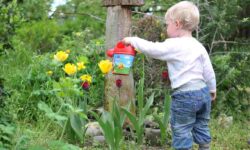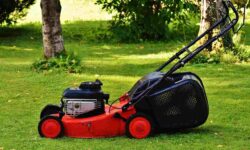Last updated on March 22nd, 2024 at 01:17 am
Gardening can be a rewarding hobby for everyone, including those with disabilities. To make this activity more accessible and enjoyable for the disabled, certain tools are essential. This article introduces ten useful gardening tools for disabled persons. These tools help overcome common challenges, allowing gardeners with disabilities to cultivate their green spaces easily and comfortably.
Let’s explore these game-changing gardening tools for disabled persons.
1. Ergonomic Hand Tools
Ergonomic hand tools are a game-changer for disabled gardeners. Designed for ease and comfort, they reduce strain on hands and wrists. Their unique shapes and soft, non-slip grips ensure better control and efficiency. These tools are lighter, offering an easier grip, crucial for those with limited hand strength or arthritis.
Look for tools like ergonomic trowels, weeders, and cultivators. They’re often curved or have pistol grips, making them easier to hold and use.
By choosing these, you’ll garden with less pain and more joy, turning challenges into triumphs in your green oasis.
2. Long-Handled Tools
Long-handled tools extend your reach, allowing you to tend to your plants without bending or straining. This means less back pain and more comfort while gardening.
You should look for tools like long-handled hoes, cultivators, and weeders. These tools come with extended grips, making it easier to handle them from a seated position or if bending is difficult. They’re ideal for wheelchair users or anyone with limited mobility.
With these tools, you can enjoy gardening without the physical strain, keeping your garden thriving and your body comfortable.
3. Wheelchair-Accessible Garden Beds
Wheelchair-accessible garden beds are designed at an ideal height, so you can easily reach them from a wheelchair or seated position. This eliminates the need to bend or stretch excessively, reducing strain on your back and joints.
These beds can be tailored to your specific height requirements, ensuring maximum comfort and accessibility. By bringing the garden up to your level, they empower you to garden independently, easily nurturing your plants. This makes gardening a more inclusive, enjoyable, and pain-free experience.
4. Lightweight Watering Can
A lightweight watering can is one of most useful gardening tools for disabled persons. It’s easy to lift and carry, reducing strain on your arms and back. This is crucial for those with limited strength or mobility issues. The design typically includes a long spout, allowing you to water plants precisely without overreaching or bending.
Some models even come with a push-button for water release, minimizing the need for grip strength. This means you can water your plants effortlessly, maintaining your garden’s beauty without physical stress. It’s a simple tool that significantly enhances the joy and ease of gardening for everyone.
5. Automatic Watering Systems
Automatic watering systems are a must-have for disabled gardeners. They eliminate the need for daily manual watering, a task that can be challenging if you have mobility or strength limitations. With these systems, water is delivered directly to your plants at set intervals, ensuring consistent hydration without physical effort.
This is especially beneficial if you find it hard to carry heavy watering cans or hoses. The systems can be customized to your garden’s needs, whether you have a few pots or a large vegetable patch. Plus, they’re a time-saver, freeing you up to enjoy other gardening activities or simply relax and appreciate your garden’s beauty.
Automatic watering systems make gardening more accessible, enjoyable, and less physically demanding.
6. Swivel Seat Garden Scooter
The swivel seat garden scooter offers mobility and comfort, allowing you to move around your garden with ease. The swivel seat reduces the need to stand up or change positions frequently, minimizing strain on your legs and back. It’s especially beneficial for those with joint pain or limited mobility.
The scooter often comes with tool storage, keeping your gardening tools within reach. This enhances efficiency and reduces the frustration of moving back and forth for tools. With its sturdy design and ease of movement, the Swivel Seat Garden Scooter empowers you to tend to your garden longer and with greater joy.
7. Grabber Tools
Grabber tools act as an extension of your arm, allowing you to reach objects without bending or stretching. This is vital for those with limited mobility or back issues. With a grabber, you can easily pick up fallen leaves, debris, or even small tools from the ground.
They also help in reaching plants that are higher up, making pruning and maintenance less of a physical challenge. Most grabbers have a trigger-like handle, making them easy to use with minimal hand strength.
This simple tool can significantly reduce physical strain and make gardening more accessible and enjoyable.
8. Adaptive Pruning Shears
Adaptive pruning shears are designed with unique features like spring-loaded handles and ergonomic grips. These modifications reduce the effort needed to cut through branches and stems. This is particularly helpful for those with limited hand strength or conditions like arthritis. The shears often include rotating handles, which align with the natural motion of your hand, minimizing discomfort and strain.
With these adaptive tools, tasks like pruning and shaping plants become more manageable and less tiring. They empower disabled gardeners to maintain their gardens with greater ease and less physical strain, making gardening a more enjoyable and accessible activity.
9. Garden Kneeler Seat
The garden kneeler seat offers dual functionality – use it as a seat or flip it over as a kneeler. This adaptability is key for those with mobility or joint issues.
As a seat, it provides a comfortable height for tending to raised beds or pots. Flipped over, it offers a padded surface for kneeling, reducing knee and back strain. The sturdy handles aid in lowering down and standing up, offering additional support.
This tool transforms gardening into a more accessible and less painful experience, allowing gardeners to enjoy their passion with greater comfort and ease.
10. Lightweight, Collapsible Wheelbarrow
A lightweight, collapsible wheelbarrow is a boon for disabled gardeners. Its light build makes it easy to maneuver, reducing physical strain, especially for those with limited strength. This is crucial in a garden setting where moving soil, plants, and tools is frequent.
The collapsible design is a space-saver, perfect for those with limited storage options. Additionally, it’s easy to set up and fold away, making the gardening process smoother and less cumbersome.
For gardeners using mobility aids like wheelchairs, its compact size and ease of use make it an ideal choice. This wheelbarrow simplifies garden maintenance, making it more accessible and enjoyable for everyone.
Why We Have Selected These Gardening Tools for Disabled Persons
Here’s a table highlighting why we’ve chosen these gardening tools for the disabled.
| Tool | Why We Selected It |
|---|---|
| Ergonomic hand tools | They reduce joint strain, making them ideal for arthritis sufferers. |
| Long-handled tools | These tools eliminate the need to bend or kneel, aiding those with mobility issues. |
| Wheelchair-accessible garden beds | These beds bring the garden to a comfortable height, perfect for wheelchair users. |
| Lightweight watering cans | They reduce the physical effort required for watering, helping those with weak grips or limited stamina. |
| Automatic watering systems | These systems assist individuals with limited stamina. |
| Swivel seat scooter | This scooter aids in mobility without requiring users to stand, which is great for those with walking difficulties. |
| Grabber tools | These tools help in reaching and picking up items without the need for bending, which is crucial for individuals with bending limitations. |
| Adaptive pruning shears | These shears require less hand strength, benefiting those with hand strength challenges. |
| Garden kneeler seats | These seats provide support for individuals with knee or back pain. |
| Lightweight, collapsible wheelbarrow | This wheelbarrow eases the transport of garden supplies, making it suitable for those with strength or mobility limitations. |
Which Types of Disabilities These Tools Support In
These tools are designed to cater to various disabilities, making gardening more accessible and enjoyable for a wide range of individuals.
Here’s a table explaining which types of disabilities these tools support:
| Tool | Supported Disabilities |
|---|---|
| Ergonomic hand tools | Arthritis, joint-related disabilities |
| Long-handled tools | Mobility impairments, back pain |
| Wheelchair-accessible garden beds | Wheelchair users |
| Lightweight watering cans | Weak grips, limited stamina |
| Automatic watering systems | Limited stamina |
| Swivel seat scooter | Walking difficulties |
| Grabber tools | Bending limitations |
| Adaptive pruning shears | Hand strength challenges |
| Garden kneeler seats | Knee or back pain |
| Lightweight, collapsible wheelbarrow | Strength or mobility limitations |
Also Read: Gardening Tools for People With Arthritis
What Precautions Should Disable Persons Take While Gardening
Sure, here are some precautions that disabled persons should consider while gardening:
- Choose raised beds or container gardening: This makes it easier to reach plants without bending or kneeling.
- Use adaptive tools: Look for gardening tools with extended handles and ergonomic designs to reduce strain.
- Install wide, flat pathways: Ensure paths between garden beds are wide and even for easy wheelchair or walker access.
- Opt for automatic watering systems: To minimize the effort of watering, consider installing soaker hoses or drip irrigation systems.
- Practice safe lifting techniques: When lifting is necessary, use your legs, not your back, and keep items close to your body.
- Take regular breaks: To avoid overexertion, work in short sessions and take breaks often to rest.
- Wear protective gear: Gloves, hats, and sunscreen protect against cuts, sunburn, and insect bites.
- Keep tools and supplies organized: Use a garden cart or caddy to keep your tools and supplies within easy reach.
- Stay hydrated: Always have water on hand to avoid dehydration.
- Seek assistance when needed: Don’t hesitate to ask for help with tasks that are difficult or unsafe to do alone.
By following these precautions, disabled gardeners can enjoy gardening safely and comfortably.
Also Read: Useful Gardening Tools for the Disabled
FAQs
What is an adaptive garden?
An adaptive garden is a flexible outdoor space designed to accommodate the needs of people with varying physical abilities. It’s a place where paths, raised beds, and seating are thoughtfully arranged to ensure accessibility and comfort for everyone, making it inclusive and enjoyable for all visitors.
What tools make gardening easier?
Tools that make gardening easier include hand trowels for planting, pruners for trimming, and kneepads to protect your knees. A watering can or hose simplifies watering, while gloves provide comfort and safety. Additionally, a wheelbarrow aids in transporting soil and plants, reducing physical strain and enhancing the gardening experience.
Also Read: Ten Useful Gardening Tools To Remove Weeds
How do you garden when disabled?
Gardening when disabled involves adapting techniques and tools for accessibility. Raised beds and containers at waist level reduce bending and kneeling. Long-handled tools extend reach, and adaptive grips assist those with limited hand strength. Planning for easy access and pacing tasks can enable enjoyable and manageable gardening for disabled individuals.
Also Read: Gardening Tools for People With Bad Backs
How do you garden when you can’t kneel?
When unable to kneel, gardening can be done by using elevated planters and raised beds. Choose tools with extended handles to reach low areas. Seated gardening on a stool or bench can also be effective. Adapt the garden layout to minimize the need for kneeling, making the experience more comfortable and accessible.
Is gardening bad for osteoporosis?
Gardening can be beneficial for osteoporosis patients if done with caution. Avoid heavy lifting and repetitive bending to reduce the risk of fractures. Use ergonomic tools, maintain proper posture, and wear supportive footwear. Consult a healthcare professional for personalized advice on safe gardening practices while managing osteoporosis.
What are the best gardening tools for seniors?
The best gardening tools for seniors are gardening tools like ergonomic hand trowels and pruners. Long-handled tools reduce bending, while kneepads or a gardening stool minimize discomfort. Raised beds and container gardens offer convenience.
Wheelbarrows aid in transporting supplies. Choosing tools with user-friendly designs helps seniors enjoy gardening with ease.
Explore These Gardening Tools for Disabled Persons
Gardening is a versatile and rewarding activity, accessible to people of all ages and physical abilities. For seniors and those with disabilities, selecting the right tools and adapting the garden layout can make the experience enjoyable and comfortable. Gardening tools for the disabled promote physical activity, mental well-being, and a sense of accomplishment.
While precautions are necessary for those with conditions like osteoporosis, with proper planning and care, gardening can remain a fulfilling and therapeutic hobby that connects individuals with nature and enhances their overall quality of life.
Affiliate Disclosure: Please note that some of the links in this post are affiliate links, and at no additional cost to you, we earn a commission if you make a purchase.
Also Check:
- Landscaping Business Names: 526+ Ideas To Inspire You
- Tips for Marketing a Landscaping Business
- How To Create a Landscaping Business Description
- How To Promote a Landscaping Business
- Gardening Tools for Kids



